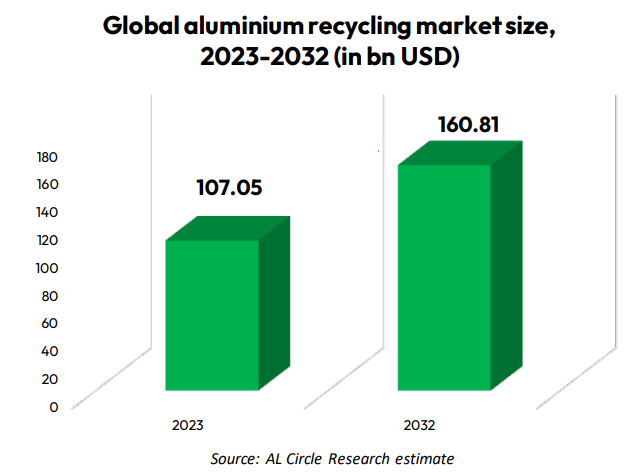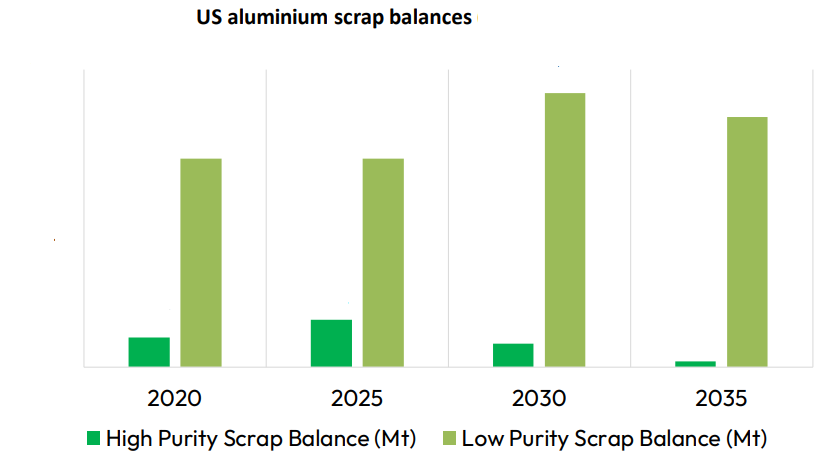World Recycled ALuminium Market Analysis Industry forecast to 2032
The updated version of our report, “World Recycled Aluminium Market Analysis – Industry Forecast to 2032”, delivers an in-depth, data-driven outlook on one of the fastest-growing segments of the global metals industry. This updated report offers exclusive intelligence on market trends, regional demand patterns, trade dynamics, policy shifts, technological advancements, and the competitive landscape shaping the recycled aluminium or secondary aluminium market. With sustainability taking centre stage in global manufacturing,
recycled aluminium is poised to play a pivotal role in decarbonising supply chains—making this report a must-have for manufacturers, investors, policymakers, and analysts looking to stay ahead of the curve.
World Recycled Aluminium Market Analysis: What’s driving the USD 160 billion opportunity?
Discover the trends, transformations, and opportunities shaping the global recycled (secondary) aluminium economy
As the world pivots toward decarbonisation, sustainability, and circular economy solutions, recycled aluminium is no longer a niche—it’s a global imperative. This comprehensive market report from AL Circle provides authoritative, data-backed insights into the future of secondary aluminium, enabling you to navigate this fast-evolving industry with confidence and clarity.
What this report delivers
- Market Forecast to 2032
- Track the global recycled aluminium market as it grows from USD 107.05 billion in 2023 to a projected USD 160.81 billion by 2032, driven by demand across construction, automotive, packaging, and electronics.

- Region-wise analysis
- Deep-dive into production, usage, policy impact, and growth potential across China, Europe, North & South America, Asia-Pacific, Middle East & Africa.
- Circular economy & ESG integration
- Explore how recycled aluminium is transforming value chains, lowering emissions by up to 95% versus primary production, and enabling net-zero commitments globally.
- Technology, trade & regulation insights
- Understand the impact of CBAM, US tariffs, the EU Green Deal, China’s Five-Year Plan, and innovations like AI-driven scrap sorting and blockchain for traceability.
- Strategic outlook on scrap supply & demand
- Analyse scrap availability by type—UBCs, extrusion, castings, zorba—and how supply constraints are reshaping market dynamics and investment priorities.

What’s new in the report
- The report will now forecast to 2032
- Analysis of the Impact of US Tariffs on the Aluminium Recycling and Scrap Market
- Impact of trade policies on global aluminium scrap flows, pricing, and industry competitiveness
- Scrap Demand and Trade: Top Importers/Exporters
- Global low carbon aluminium production: Secondary Aluminium Vs Primary Aluminium
- Recycled aluminium: Market share by product form: Ingot-Billet-Slab
- Major country-wise market analysis other than region-wise
- Analysis of key market players based on shipping volumes of secondary aluminium ingot, price and quantity (selected participants)
- Old & New scraps recycling market shares by volume & regions, 2013-2024
- Key advancements and innovations in aluminium recycling techniques
- List of Scrap Suppliers, Their Products, and Countries

Methodology
1) Scope
This report essentially covers – (1) Recycled aluminium usage and forecast across regions (2019 - 2032), (2) Recycled aluminium usage by end-user sectors (2019 - 2032), 3) Applications of recycled aluminium, (4) Overview of aluminium recycling and pollution control, 5) Aluminium recycling - technological developments (including case study), (5) Investment & expansions in recycled aluminium sector, (6) Global trends in aluminium scrap collection and recycling, (7) Scrap demand & trade (pre & post consumption scrap).
2) Data collection
Advanced Internet research: In-depth research has been performed for data collection. The primary sources include the International Aluminium Institute (IAI), International Trade Council, International Organization of Motor Vehicle Manufacturers (OICA), AL Circle recycling e-Magazine, published articles, company reports and publications, ASI certificates, journals, and white papers.
Review of the database - The curated database, with the input of subject matter experts, includes facts and figures from AL Circle (www.alcircle.com) news, blogs, interviews, and press releases.
3) Research & analysis
The facts and figures in this report are derived from comprehensive market research analysis, which includes collecting and examining historical data, reviewing research reports, and calculating compound annual growth rates.
By evaluating reports & trade data sourced from the International Aluminium Institute (IAI), International Trade Council, European Circular Economy Stakeholder Platform, publications of European Aluminium, and sustainability reports from various companies around the world.
Who should read this report?
This report is designed for decision-makers, innovators, and professionals across the global aluminium value chain who need actionable intelligence on recycled aluminium markets, policy impacts, and sustainability-driven growth.
- Aluminium recyclers & secondary producers
- Stay ahead of demand trends, technology advancements, and scrap sourcing challenges. Benchmark your capacity, product mix, and regional positioning against industry leaders.
- Primary aluminium producers
- Gain insights into secondary market disruptions that may impact their cost structure, ESG goals, and downstream client preferences. Explore opportunities for integration, green product development, or scrap acquisition.
- Automotive, packaging & construction manufacturers
- Understand how recycled aluminium is reshaping material sourcing, cost competitiveness, and compliance with net-zero and circular economy targets.
- Metal traders, scrap dealers & procurement heads
- Track shifts in global scrap trade flows, regional imbalances, pricing volatility, and opportunities in underserved markets.
- Investors, private equity & strategic consultants
- Identify regions and companies primed for growth, M&A, or expansion, especially in high-potential segments like billets, slabs, and dross recovery.
- Government bodies & policy think tanks
- Use this report as a framework to design or evaluate recycling-friendly industrial policies, CBAM-readiness, and low-carbon infrastructure planning.
- ESG, circular economy & sustainability professionals
- Quantify recycled content impact, traceability challenges, and energy savings across sectors. Track decarbonisation pathways and Scope 3 emission reductions.
- Technology providers & equipment manufacturers
- Find market-entry insights into regions investing in sorting, melting, dross recovery, and AI-enhanced scrap processing technologies.
- Academics & research institutions
- Access detailed data, case studies, and forecasts for further study into decarbonisation, resource efficiency, and industrial sustainability transitions.
Frequently asked questions
This report stands out with its comprehensive global scope, in-depth regional analysis, and integration of trade data, technology trends, and sustainability insights. It includes exclusive case studies, forecasts, ASI certification updates, and a detailed appendix with import-export data, making it a one-stop reference for industry stakeholders, policymakers, and investors.
Aluminium recycling plays a critical role in reducing energy consumption, lowering greenhouse gas emissions, and conserving natural resources. Unlike primary production, secondary (recycled) aluminium requires only about 5% of the energy. With growing regulatory pressures and climate goals, industries are shifting focus to recycling as a viable route for sustainable growth.
Regions such as China, Europe, and North America dominate aluminium recycling volumes. However, emerging markets like India and the Middle East are rapidly investing in infrastructure. Global trends indicate a rising shift toward automation, advanced sorting technologies, and increased regulatory support, especially in Europe and Japan.
Key end-use sectors include automotive, construction, packaging, electrical, and consumer durables. Automotive and packaging, in particular, benefit from aluminium's light weight and recyclability, aligning with sustainability goals and circular economy initiatives.
Trade policies, especially US tariffs on aluminium imports, have disrupted traditional trade flows, affecting scrap prices as no tariffs have been added and resulting to availability. These shifts have encouraged some countries to become more self-reliant in scrap sourcing and prompted investments in domestic recycling capacity.
Primary aluminium producers are embracing recycling through brownfield projects and scrap integration to reduce energy costs and carbon emissions. Recycling uses only ~5% of the energy required for primary production, aligning with global sustainability goals. Increasing customer demand for low-carbon aluminium, especially in sectors like automotive and packaging, is driving this shift. Regulatory pressures and ESG commitments further compel producers to diversify their operations. Brownfield expansions offer a faster, cost-effective route to scale recycling capacity and meet market expectations.
The report offers actionable intelligence on market dynamics, regional usage patterns, scrap supply-demand, key players, and upcoming investments. This enables users to identify growth opportunities, benchmark against competitors, plan supply chain strategies, and align with evolving environmental and trade regulations.





